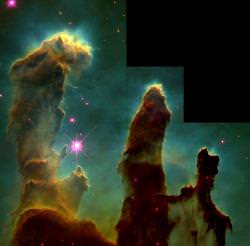After the Big Bang, all we had was hydrogen, a little bit of helium, and a few other trace elements. Today, we’ve a whole periodic table of elements to enjoy, from oxygen we breathe to the aluminum cans we drink from to the uranium that powers some people’s homes. How did we get from plain old hydrogen to our current diversity? It came from stars; in fact, successive generations of stars.
Click here to download the episode
Stellar Populations – Show notes and transcript
Or subscribe to: astronomycast.com/podcast.xml with your podcatching software.


Iron forms molten cores inside terrestrial planets. Also it’s very stable element, perhaps the most compact or dense. Heavier metals don’t have that tight inertia, perhaps contributing to the small angular momentum allowing pulsars to spin faster.
My guess is that since iron doesn’t decay like heavier elements, that it stellar-accumulates. I feel irons ability to produce strong magnetic fields enhances terrestrial planet formation & habitability. I would like to send out a satellite w ability to “Magnetically Map the Universe” for Laszlo(MULL).
Lets mull it over.
i have not been able to download either stellar pop.’s or antimatter for many days now and from different locations. What’s up?